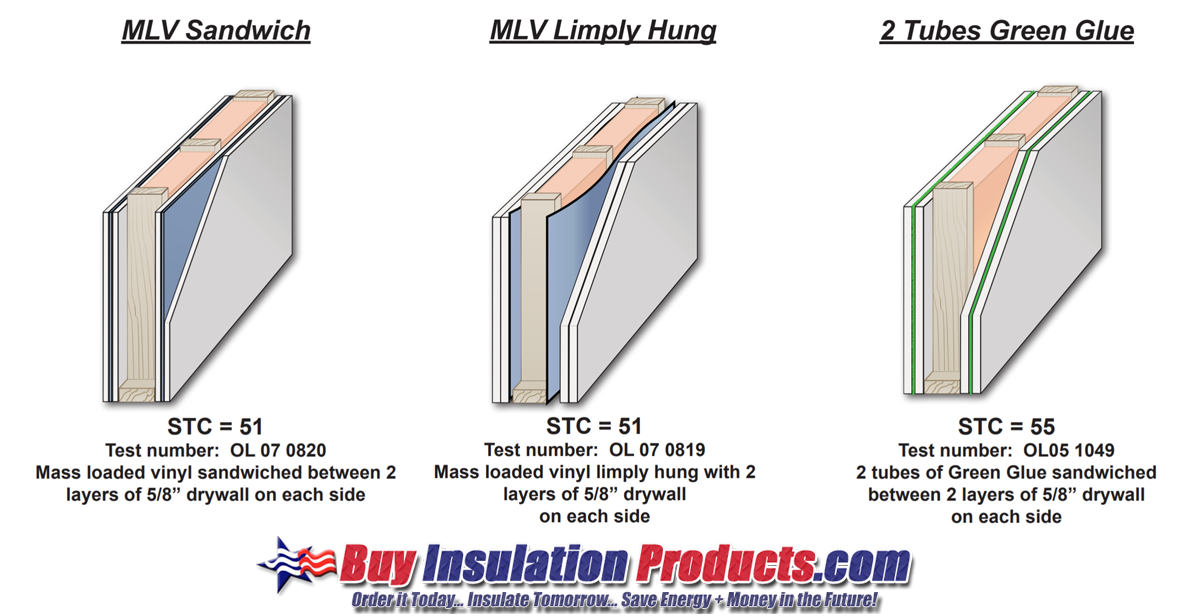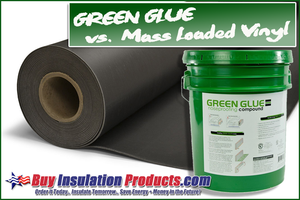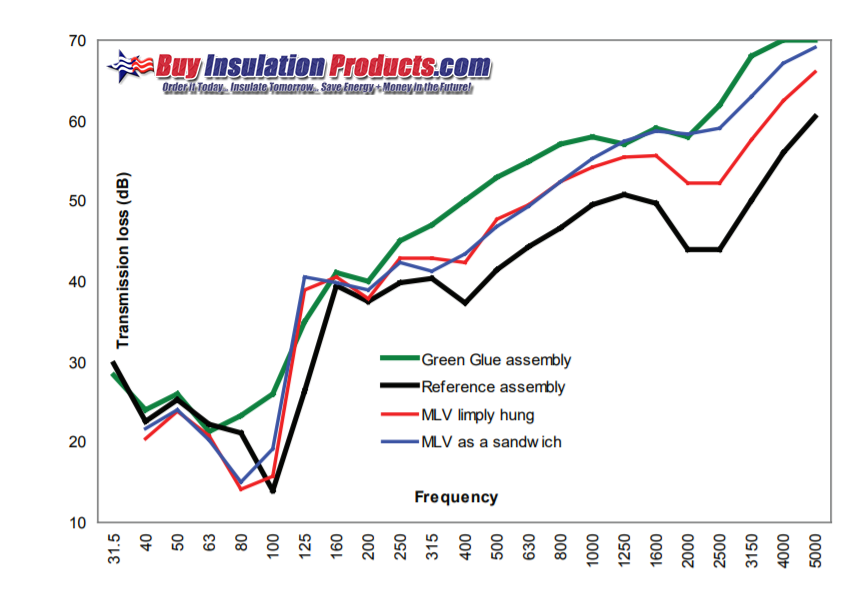Green Glue vs Mass Loaded Vinyl Noiseproofing Compound
Posted by BIP - Testing/Charts Published by Green Glue on 29th Jan 2020
Green Glue Noiseproofing Compound vs. Mass Loaded Vinyl:
Green Glue and Mass Loaded Vinyl noiseproofing compounds are not actually competitive products however they are both used as "soundproofing" materials. This article is going to show the Sound Transmission Class compares in wall structures that include Mass Loaded Vinyl and a wall that includes Green Glue.
What is Mass Loaded Vinyl?
Mass Loaded Vinyl is a a thin flexible barrier which is comprised of PVC or barium based ingredients. Mass Loaded Vinyl is designed to be very dense yet remain flexible and limp. The dense yet limp material is designed to block sound transmission and prevent sound transmission from going through the barrier. MLV is either installed directly to the wall studs (ceiling floor joists) or sandwiched between two layers of drywall (plywood, subfloor,etc).
What is Green Glue Noiseproofing Compound?
Green Glue Noiseproofing Compound is a viscoelastic damping compound that is used between layers of drywall in walls, ceilings, and floors to drastically dampen vibrations. By damping these vibrations, Green Glue compound is able to reduce the amount of sound transferring from one side of the structure to the other.
The Test:
We will discuss the results of four separate wall structures including Sound Transmission Class (STC Value) as well as the transmission loss at varying frequencies.
The tests we will discuss involve four separate walls listed below:
*All walls have Wood Studs and R-13 Fiberglass Batts
- Reference Wall: 2 Layers of 5/8" Drywall (on Both Sides)
- MLV Sandwich: 5/8" Drywall / MLV / 5/8" Drywall (on Both Sides)
- MLV Limply Hung: MLV installed directly to stud (on both sides) with 2 Layers of 5/8" Drywall (on Both Sides)
- Green Glue: 5/8" Drywall / 2 Tubes of Green Glue / 5/8" Drywall (on Both Sides)
The Results:
STC Values:
- Reference Wall: STC 45
- MLV Sandwich: STC 51
- MLV Limply Hung: STC 51
- Green Glue: STC 55
Sound Transmission Class is an average performance over all audible frequencies so a lower STC Rated Wall can actually be more desirable depending on what level sound frequency we are trying to stop. Because of this fact we cannot end our test here and say that the Green Glue wall wins because of its STC 55 (4 points higher than the MLV Sandwich). We need to analyze the transmission loss across the frequencies to make sure the average is not skewed on one end of the spectrum. Below is an image showing the three test wall structures along with their STC values.
Transmission Loss at Frequencies:
The chart shown below lists all four walls which are color coded per the legend. The charts vertical side is Transmission Loss in Decibels. The higher the number the better for blocking sound. The charts horizontal side is the noise frequency, the lower the number the lower the frequency (bass).
- Up to 63 hz Mostly inaudible to the human ear. The 4 walls all perform within a few Db of each other.
- 80 to 100 hz - The 2 walls with MLV perform worse than the reference wall (not good for bass).
- 125 to 200 hz - All 4 walls perform similar with both MLV walls having slight advantage at 125 hz.
- 250 to 1250 hz - Green Glue wall outperforms all while two MLV walls perform 7-8 Db better than the reference wall.
- 1250 to 2000 hz - Green Glue and MLV Sandwich wall are equals and outperform the others
- 2500 to 5000 hz - Green Glue performs best, MLV Sandwhich is a close 2nd.
From this chart you can see that for the most part adding Mass Loaded Vinyl or Green Glue to a wall will greatly increase the transmission loss at frequencies above 250 hz. Green Glue has a clear advantage over Mass Loaded Vinyl besides 1250 hz to 2000 hz where the MLV Sandwich performs equally as well. The most impressive yet overlooked part of this test is how Green Glue performs at 80hz to 100hz. Green Glue greatly outperforms both MLV walls by nearly 10 decibles at this low frequency point.
Conclusion:
The transmission loss chart and STC values clearly show that Green Glue Noiseproofing Compound "wins" the competition. Green Glue offers a +10 STC point increase from the reference wall and a +4 point increase over both MLV walls. The chart shows that the Green Glue wall performs better at almost every frequency.
This competition between Mass Loaded Vinyl vs Green Glue is somewhat flawed because these products stop sound through two different principles. Mass Loaded Vinyl is about adding Limp Mass to a wall, while Green Glue dampens the wall. Both of these products can be and are commonly used in conjunction.
Our first question is, where is the test wall that includes MLV and Green Glue? The answer is, the test doesn't exist because neither the Green Glue Company or manufacturers of MLV receive any benefit for paying for and publishing such results. With soundproofing it's never good to assume, but one can deduct that a wall that contains MLV and Green Glue will benefit from additional limp mass along with the proven damping qualities of the Green Glue.
*Note: All testing and charts were published by the Green Glue Company. Testing was performed by an independent lab. The brand of mass loaded vinyl used in the test is not disclosed.


